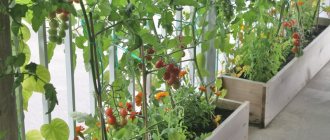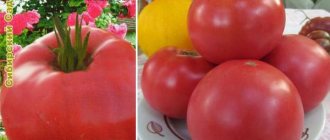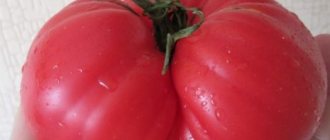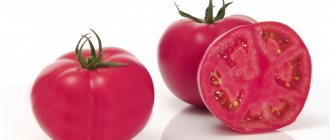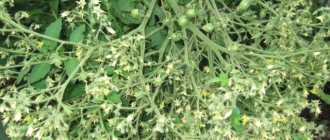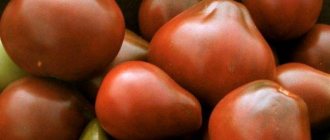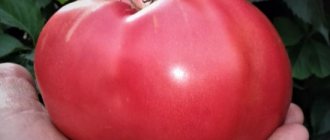a brief description of
Children's Joy is a variety, not a hybrid, which means, firstly, you can produce your own seeds, and secondly, expect a truly sweet taste from ripe fruits. To plant seedlings you will need a little space: the bushes are low (0.6 m), compact, up to 6 roots can be placed per square meter of ridge.
Despite their small growth, the bushes need support - without it, the plants may not be able to support the weight of the fruit. Small pegs are suitable, no longer than 1 m. When testing the variety, yields of 6 kg/m² were obtained. Comments from summer residents confirm the stated characteristics.
The fruits of Children's Sweets are not large, weighing only 50 - 70 g. The shape is slightly elongated, oval. The skin is smooth, durable, and red when ripe. The pulp is aromatic, tasty, juicy. The fruits are universal in purpose. The size of tomatoes is optimal for whole-fruit canning. Fresh fruits are tasty and healthy.
Description and characteristics of the variety
Children's sweetness is an early-ripening determinate variety of tomatoes that is characterized by low growth. Typically, tomato bushes grow up to 0.5-0.6 meters, but at the same time they require reliable tying to a support and partial pinching. To obtain a rich harvest, it is necessary to form a tomato bush up to the first bunch.
The main differences between tomatoes of the Children's Sweet variety:
- oval shape;
- smooth skin;
- red color of ripe tomatoes;
- weight is 50-70 grams.
It should be noted that the tomato variety Children's Sweetness allows you to get up to 6 kilograms of fruit per square meter.
Diseases and pests
The late blight variety Children's Sweetness is practically not infected, since it has a short growing season. The fruits ripen early and early, before late blight begins to spread.
Modern selection has made the Children's Sweet variety resistant to some diseases:
- fusarium;
- verticillium;
- blossom end rot of fruits.
However, preventive measures are needed. In order to prevent diseases and obtain healthy tomato seedlings, the seeds are soaked in a solution of potassium permanganate before planting. Before planting, the soil is shed with a solution of Fitosporin.
Advantages and disadvantages
Tomato Children's joy
Advantages of the variety:
- early harvest,
- plants require minimal care,
- fruits are sweet, resistant to cracking,
- tolerate long-term storage and transportation well,
- The plant is characterized by immunity to diseases: verticillium blight, blossom end rot and fusarium blight.
The variety has virtually no drawbacks, which explains its growing popularity. If we compare the sweet tomatoes Children's sweetness and Vkusnyashka, then the second variety has a longer growing season and smaller fruits.
Agricultural technology
To correctly calculate the timing of sowing, the characteristic ripening period is used, which for Children's sweets is short, 80 - 90 days. The tomato is early, so seeds for seedlings can be planted in early April. At the end of May, 40-day-old seedlings can be transplanted into open ground.
A description of the planting scheme is given on the seed package. - recommends placing up to 6 bushes per square meter, maintaining an interval between plants of 40 cm, between rows - 50 cm. Summer care of tomatoes is usual, consists of watering, fertilizing, weeding.
Watering
It is better to water low-growing bushes in the morning. Make sure that drops of water do not fall on the stems or leaves. The optimal water temperature is 20 to 25 °C. It is better to let the liquid stand before watering. Rainwater brings more benefits when growing tomatoes. If it gets cold outside, watering should be stopped, and if watered, then with warmer water (30 °C).
Feeding
For sweet varieties of tomatoes, use an aqueous solution of potassium chloride and table salt. In a bucket of warm, settled water, dissolve a tablespoon of both. 0.5 liters of nutrient solution is poured under the root of each bush.
Nitrogen fertilizer, urea or ammonium nitrate must be applied once after replanting the Children's Sweets on the ridge. During the summer, feed with phosphorus-potassium fertilizers, not forgetting about other microelements: magnesium, boron, iron. Plant leaf parsley next to the bushes of Children's Sweets - there will be more sweetness in the tomatoes.
Growing seedlings
Children's sweet tomatoes are preferably grown using seedlings. This way, from the seed it will be possible to obtain a strong plant, which in the future will take root well in the soil and produce a high-quality harvest. However, according to reviews from experienced gardeners, the crop can also be successfully grown by direct sowing into the soil. However, this method is only suitable for regions where warm weather prevails. Therefore, seedlings are recommended for most areas.
Related article:
Cherry tomatoes: TOP 5 best varieties for home canning
Sowing of seeds is carried out 50-60 days before transplanting the plant to the beds. Ready-made bushes can be planted at the end of May, so seedlings begin to be prepared in late March - early April.
Sowing is done in shallow containers in furrows of 1-1.5 cm. Seeds are sown in heaps, or leaving a distance of 3-4 cm between the minis (this way there will be no need to thin out excess seedlings). In addition, sowing can be done in individual seedling cassettes, where 1-2 seeds are placed in one cell. After germination, it is easier to pick them out, minimizing the risk of injury to the root system.
It is better to buy soil for sowing ready-made at a gardening store (universal substrate for vegetable crops). This greatly simplifies the work, since the soil from the garden or vegetable garden must be disinfected and enriched with nutrients. Before sowing, the substrate is watered so that the soil is moderately moist. After the seeds are placed in the holes, a small layer of soil is sprinkled on top and watered with warm filtered water. The seeds should not be at a depth of more than 2 cm, otherwise it will be difficult for the sprouts to break through. After planting, the container is covered with an airtight transparent material (glass, polyethylene) and placed in a warm place.
Related article:
Tomato Golden Domes - description and characteristics of a mid-season variety
When the first shoots appear, the film or lid is removed and the containers are transferred to a bright windowsill or nursery. Tomatoes must receive maximum light, so when there is a lack of light (for example, cloudy days are often observed or the window is shaded by trees and buildings), fluorescent lamps are used. Additional lighting is installed above the container at a distance of 10-15 cm from the sprouts, depending on the power of the equipment.
Planting of seedlings is carried out in the phase of two true leaves. It occurs approximately two to three weeks after the appearance of the first shoots. Picking consists not only of replanting the plant in individual large containers (250-300 ml), but also pinching the main root. This procedure has a beneficial effect on the development of the tomato and makes its root system powerful and branched. As a result, the bush will receive more nutrients from the soil, which will have a positive effect on the quality of the fruit.
Related article:
What to do if tomato seedlings have stopped growing
Picking is done as follows:
- The soil in the container with seedlings is well moistened.
- The seedlings are dug up a little with a spatula and carefully removed from the soil.
- The main root is pinched 1/3 with your fingers.
- Make a deep hole in the soil of the new container using a peg or any other long cylindrical object.
- The tomato, held by the cotyledon leaves, is immersed in the hole along with the stem. Thus, new roots will appear from the stem, increasing the volume of the plant’s root system.
- The seedling is carefully buried and watered with water at room temperature.
Further care of seedlings Children's sweetness consists of regular watering, loosening the soil and applying fertilizers. Tomatoes are watered 3-4 times a week, not allowing the soil to dry out. Fertilizing consists of applying complex mineral fertilizers containing nitrogen, phosphorus and potassium every 14 days. The first fertilizing is applied about a week after picking the tomatoes.
Related article:
Secrets of growing tomatoes from experienced gardeners
To make tomatoes sweet - tips
Do you want to grow sweet tomatoes? Listen to the advice of experienced gardeners:
- Choose a well-lit area: the more sunlight the tomato bush receives, the more sugary the ripe fruits will be.
- Moisture is also needed for sweetness - a low-growing bush needs at least 2.5 liters of water per watering.
- Pick a Children's Sweet tomato when the fruit turns completely red - the riper the tomato, the more sugars it contains.
- Adhere to the following order when applying fertilizers: fertilize the first time 2 weeks after transplanting, and the second time when the tomatoes are already hanging on the bushes.
- Help tomato bushes pollinate - shake them at least 2 times a week.
- Make life easier for the tomato by removing the lower shoots located below the first flower cluster.
- When the tomatoes are ripe, reduce the intensity of watering.
- Remove tomatoes from the vines if nights become cold and the mercury drops to 8°C or below. Let the tomatoes ripen in the boxes.
See also
Description of the tomato variety Cetus pink, its characteristics and yieldRead
Features of cultivation and care
The variety was bred for cultivation in cultivated structures. The requirements for agricultural technology in this case are identical to those applied to the crop as a whole. The need for pinching and gartering on the trellis has already been mentioned above. It is worth dwelling on the following points:
- during picking, seedlings must be fed with mineral fertilizers;
- subsequently, organic matter, iodine, and yeast are used as the main nutrition;
- watering is carried out only with warm water;
- after loosening the soil, mulching is desirable;
- it is necessary to monitor the cleanliness of the beds, removing weeds in a timely manner;
- It is recommended to form the bush into 2 trunks;
- drafts are completely eliminated in the greenhouse.
To protect the variety from late blight, special efforts are made to preventive measures. In addition to the annual disinfection of buildings and soil, it is recommended to periodically spray the plants with fungicides (Hom, Quadris, etc.), copper oxychloride, and Bordeaux mixture. Biological products have proven themselves well - “Baikal”, “Fitosporin”, “Guapsin” and others.
Productivity and purpose of tomato
The fruits of the “Children's Sweetness” variety are small and ideal for canning and fresh consumption. Tomatoes can be processed into: sauces, ketchups, tomato juice. The pulp is juicy, but not watery. Whole canned tomatoes will be an excellent addition to your everyday and holiday table.
The tomato harvest is high. From one meter of plantings 5.5-6 kg are collected. For a determinate plant, this yield indicator is high. The short ripening period makes it possible to harvest tomatoes as early as July, which of course is good news.
Growing tomato "Children's sweetness"
- Despite the resistance to some types of diseases, treat the seeds before planting with a solution of potassium permanganate. Preparation of solution: 100 ml. water and 1 g. potassium permanganate. Soak the seeds for 20-25 minutes, then rinse with water. Seeds are planted to a depth of 1-2 cm.
- To prevent plant diseases, the holes must be watered with an antibacterial agent, for example, Fitosporin, before planting. For one square meter you will need 10 liters. water and 1 tablespoon of the drug.
- The main feeding of the plant is done during the period of flowering and fruit set. During this period, the plant needs potassium and phosphorus fertilizers. Feeding consumption per 1 m² is 30-50 grams.
- Constantly weed and loosen the soil. Weeding is necessary to destroy weeds, and loosening allows the roots to absorb the missing amount of oxygen from the air.
- Place pegs near the bushes and tie up the tomato so that a large number of fruits does not break the plant.
- You don’t have to water the tomatoes often; twice a week will be enough.
Important! Tomato pests can include: wireworms, Colorado potato beetles, cutworms, aphids, and whiteflies. You can fight them with the following drugs: “Bazudin” (wireworm), “Proteus” (aphid), “Phosbecid” (whitefly), “Proteus” (cutworms), “Bombardir” (Colorado beetle).. {reklama}
{advertising}
Pink fruits
The sweetest pink varieties of tomatoes include the following names.
Tomato Sweet barrel is recommended to be grown in greenhouse conditions. The Sweet Barrel tomato is characterized by medium limits of fruit ripening; you can taste the harvest after 115 days.
The Sweet Barrel tomato belongs to the indeterminate type. It can reach up to 2 meters. Requires tying and shaping of the stem. A prerequisite is the removal of side branches and old leaves. To increase disease resistance, the Sweet Barrel tomato is treated with special preparations at intervals of two weeks.
There can be 5-6 tomatoes ripening on a bunch. Brushes must be protected from damage. The Sweet Barrel tomato produces pink-colored fruits that weigh about 220 g and are fleshy and sweet inside.
The Pink Honey tomato belongs to the determinate, mid-early group. In greenhouse conditions it grows up to 140 cm, in open beds up to 60 cm. Care requires pinching and tying. Tolerates drought well. Rose honey is famous among gardeners for its huge fruits. Large, heart-shaped tomatoes can weigh 1 kg. The pulp of Pink Honey is fleshy, dense, and sugary. According to reviews, tomatoes are poorly stored and crack quickly.
How to sow tomatoes with seeds in the ground
Sow with dry seeds. Mark the holes at a distance of 40 cm from each other. Water the soil in the holes with warm or hot water. Plant at least 3 - 4 seeds in each hole. The seeds should be covered with humus 1.5 cm thick.
Cover the holes with film. The seeds will sprout quickly. Gradually remove the weaker plants, leaving one of the strongest bushes for each hole. Further care is carried out as when planting tomato seedlings.
"Sweet Bunch"
Official information
It took only 1 year to conduct tests and introduce the variety into the register of breeding achievements of the Russian Federation.
And in 2009, the variety was legalized under number 9153937. The applicant and originator of the variety is Agrofirma Sedek LLC, Moscow region, Domodedovo.
The variety is recommended for cultivation in all regions of the country under film greenhouse shelters and in open ground in private gardens of flower growers as an early ripening variety.
Of the entire series, only the “Sweet Bunch” variety has legal rights to exist. However, the market is filled with other “bunches”.
Characteristics of the variety
Considering the “Sweet Bunch” tomato, the characteristics and description of the variety indicate that the plant is indeterminate. The growth of the main shoot does not stop until we ourselves interrupt it. Often the plant reaches the height of a greenhouse and 1.8 m in open ground.
The leaf blade is large, dark green. The plant has good foliage.
Fetus
The tomatoes are round, smooth and dense. In full biological ripeness, uniform red color.
There are two nests. The seeds are small. Tomatoes weigh from 20 to 30 g, there is no uniformity in weight. Ripening is also not uniform, so the bunch initially does not have uniformity in color.
The taste quality is rated “good”, but those who have already grown tomatoes speak of a satisfactory taste, since they expected a sweet taste from a sweet bunch. The balance of organic acids and sugars is not organic enough and the sweetness is not felt.
The dense skin of a tomato protects the fruit well from cracking, both on the bushes and during heat treatment, but when eaten, you feel that it is extremely dense and “annoying.” Many vegetable growers, describing their impressions of the variety, consider the skin to be one of the stopping factors, and it is because of this feature that they refuse to grow tomatoes.
Use of commercial tomato
Small tomatoes can be used as a decoration for cold appetizers, canapés and sandwiches. They will decorate vegetable and fruit cocktails and vegetable slices.
Tomato behaves well when canned with whole fruits. Having selected them according to color and size, you can fill them with both marinade and tomato juice.
Whole fruits, canned in tomato juice, are served in solyankas, and they serve not only as filling, but also as decoration.
The tomato does not burst during heat treatment. Some housewives, fearing that the fruits will lose their integrity, prick them with a needle, but there is no need to use this technique for the “Sweet Bunch” variety.
When using the fruit in fresh salads, many vegetable growers complain that they need to be blanched before serving because the skin is uneatable.
Productivity
The registration commission legalized the yield within 3.5 kg per square meter of film shelter area.
Those who have already grown tomatoes agree with the official figures and consider it completely unprofitable to occupy expensive land for such a barren variety.
Sustainability
The registration commission did not bother to describe the variety's resistance to contagious tomato diseases.
When grown in a greenhouse, there are no special nuances with diseases and pests. When grown in open ground, and even under unfavorable weather conditions, reviews repeatedly say that the tomato is not resistant to late blight.
Advantages and disadvantages
Considering the advantages of the “Sweet Bunch” variety, the following points can be noted:
- early ripening and rapid delivery of fruits to the table;
- tomatoes tolerate heat treatment well while remaining intact.
The variety also has a number of significant disadvantages:
- low yield;
- the need for constant stepsoning;
- instability to late blight;
- satisfactory taste of fresh fruits;
- very thick skin.
Features of cultivation
Since the variety is tall, tying the shoot to supports is a natural step. However, the “Sweet Bunch” variety has the property of excessive formation of stepsons. To keep the tomato “within limits” it is necessary to regularly and timely remove the stepsons.
Maintaining a culture in two shoots is the most optimal. Increasing shoots does not provide a significant increase in yield.
Variety variety
In this series, under the general name, fruits with a different color are grown - chocolate, golden. But these varieties are not reflected in official registers. According to the main characteristics, they are identical to the red original, but there are some differences.
table 2
Varieties of “Sweet Bunch” tomatoes
| Chocolate | Golden |
| Despite its indeterminate nature, the bush stops its growth on its own at a height of 1.7 m Externally, the fruits resemble dark cherries with a chocolate tint. When cut, the flesh is dark red in color and stands out for its juiciness. Tomatoes have 4-5 seed chambers The sweetness is more pronounced than that of the main variety and leaves behind a long, pleasant aftertaste. | Bush growth stops at a height of 150 cm The foliage is not as strong as the original, but the branching is increased The shape of the fruits is more like a yellow pear. The pulp has the same shade There is an increased content of sugars, which provides a pleasant sweetness to the fruits |
The “Sweet Bunch” varieties are just as productive, hold their shape well and are versatile in consumer terms.
Summer residents about the variety
Reviews about the variety can help with choosing tomatoes for the new season.
Tatyana, Leningrad region:
“I was pleased with the yield of this low-growing tomato. The strong, compact bushes were strewn with red tomatoes. We didn’t have to wait long for the harvest—the tomatoes began to ripen in June. There was no late blight on the bushes, nor any other diseases.”
“I don’t have a garden, just a small piece of land in front of the house. I wanted to grow tomatoes, so I bought Children's Sweet seeds - I chose low-growing and early ones. I planted Children's sweets in a barrel of soil. I planted 5 seeds, they all sprouted, and I left three of them. At first, while it was cool outside, the barrel was covered with agrospan. The tomatoes turned out to be tasty, they started singing early.”
New comments from someone who planted Children's Sweetness in open ground or in a greenhouse can make the choice easier. Share your impressions, give your independent assessment.
